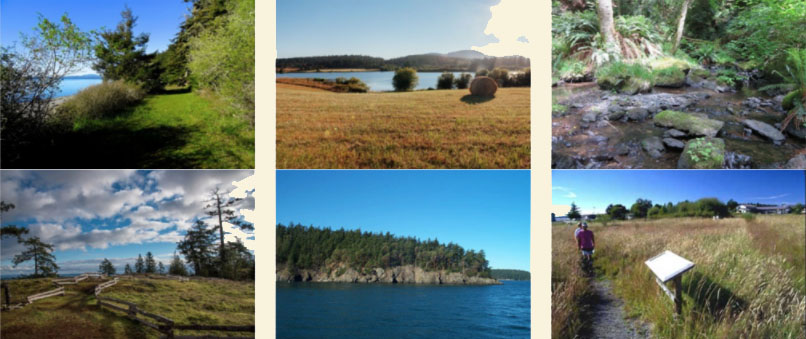||| BY STEVE BERNHEIM, REPORTER |||
Friday morning, September 17, San Juan County’s Community Development staff met with the Planning Commission to give an update on the six-year Transportation Improvement Program (TIP) and to deliver briefings on how rural residential cluster developments, vacation rentals, and accessory dwelling units will be treated in the County’s 20-year comprehensive plan for 2016-2036, now being written.
But first, local residents called in during Public Access Time to support revision of the County Council Vision approved in 2018, revisions that would emphasize environmental and social coexistence over permissive commercial exploitation. The speakers were Chom Greacen, Kai Sanburn, Julienn Battalia, Nick Teague, and Liz Lafferty from Community Rights San Juan Island. County Council candidate Ryan Palmateer and Orcas resident Sharon Abreu also spoke.
Staff updated the Planning Commission on the six year TIP, itemizing two completed projects and five discontinued ones. On Baler Hill Road — where drivers’ routine unsafe driving and violations of traffic laws endanger cyclists and pedestrians on a narrow roadway — staff explained that while separate walk/bike trails might help preserve rural character degraded by roadway widening, fuel tax money available for the safety improvement can be spent only on the road and not on separated road-side safety trails. The Commission agreed that design standards to preserve rural character in the execution of transportation projects should be considered for inclusion in the transportation element of the comprehensive plan.
Staff next briefed the Commission on draft comprehensive plan sections and code amendments to allow more rural residential cluster developments as a possible way to increase affordable housing in rural areas: staff had recommended increasing the number and size of dwellings permitted and allowing private in addition to nonprofit construction and development. Commission members reached no conclusion on the staff proposals.
After a break for lunch, the briefings continued. Staff addressed how vacation rentals (VRs) and accessory dwelling units (ADUs) might be treated in the draft comprehensive plan in order to increase affordable housing and decrease disorder from unruly tourists.
On vacation rentals, staff wanted the Commission’s answers to two questions: should the number of VRs be limited to add long-term housing units and prevent over-tourism ? Should VRs be restricted in the “urban grown areas” (UGAs) of Eastsound, Friday Harbor and Lopez Village to protect neighborhoods from being taken over by disrespectful visitors? The Commission supported limiting VRs to one per parcel in the UGAs, but then without staff review or recommendation, the Commission voted that homeowner associations should have no role in staff review of a VR permit application, even when HOA rules prohibit vacation rentals.
The last subject of the day dealt with the treatment of accessory dwelling units (ADUs) in the draft comprehensive plan. Staff briefed and the Commission talked about making ADUs for affordable housing exempt from the annual ADU lottery and allowing affordable ADUs to be bought and sold separately from the land. Then how quickly it was almost four o’clock! Scheduled discussion of agricultural, forest, and mineral resource lands was postponed. Seven and a half hours after the briefing began at 8:30 a.m., the Commission adjourned.
There are nine seats on the Planning Commission, three are vacant; member Georgette Wong last attended a meeting February 2020.
**If you are reading theOrcasonian for free, thank your fellow islanders. If you would like to support theOrcasonian CLICK HERE to set your modestly-priced, voluntary subscription. Otherwise, no worries; we’re happy to share with you.**








I think it’s outrageous to ignore HOA rules in permitting vacation rentals. HOA rules are a tool for carrying out homeowners’ wishes and one of the few ways we have of controlling VRs — unless, or until, the Council acts. I hope they do so very soon.
Perhaps someone from COMMUNITY RIGHTS San Juan can clearly and concisely define or explain the following:
(1) What and where codified are the so called COMMUNITY RIGHTS? (i.e What are they please and from where do they derive authority?)
(2) Please detail precisely what is meant by the phrase: “environmental and social coexistence over permissive commercial exploitation”
Thank you.
Mr. Cohen, there is a link to the organization in the article where your questions are addressed. https://rightsofthesalishsea.org/
Steve–Seriously, “unruly tourists” and “disrespectful visitors”? Were those terms actually used by the Commission or the Staff? We all have our own feelings about tourists, but that kind of language doesn’t belong in a government proceeding.
Regarding County enforcement of HOA rules: An HOA is responsible for setting and enforcing its own bylaws, etc. The County should not and probably cannot undertake enforcement of a private association’s rules against a private member. Apart from not engaging in litigation on behalf of a private party (HOA), many HOA rules are vague or hopelessly outdated and are a black hole of contentious and expensive litigation.
The notion of limiting VRs to the “urban grown areas” (UGAs) of Eastsound, Friday Harbor and Lopez Village to protect neighborhoods from being “taken over” by those noisy and disrespectful tourists seems odd; it is the folks in the UGA who by definition have smaller lots that bring them into closer contact with V-renters. It seems like amount of separation from neighbors should at least be considered.
Peg, respectfully, is that a correct reading? The article said, “limiting VRs in UGAs,” and you address “limiting VRs to UGAs.
I think the issue in limiting VRs in UGAs has to do with the fact that a permit is not required for VRs in UGAs. Confirm? Thanks.
Vacation rental permits are required for the Urban Growth Area, but not for the Eastsound commercial zone. The commission’s discussion was well-rounded, and within their discussion about density they touched upon ideas regarding limiting future VRs “to” just the Urban Growth Areas, only outside of the UGA boundaries, and also limiting vacation rentals “in” UGAs (which they did).
Their support of limiting the number of vacation rentals in UGAs was in regards to density. To highlight this the SW corner of Eastsound’s UGA was highlighted by a map showing that 19 of the 36 homes in the area coming into town (where it slows down to 25MPH on the curve) are VRs. Noise was not the only criteria for using density as a performance metric in their analysis, as it’s only one of the known negative factors attributed to the operation of transient rentals. The decision to support “1” vacation rental permit per parcel (regardless of property size) in the UGA was because some property owners rent both their main houses and their secondary dwelling units, and also they felt it wouldn’t be fair to tell one person they couldn’t have a vacation rental because their lot size was too small, when on the other hand there were already approved permitted vacation rentals on some small parcels.
Michael, those explanations are much appreciated!